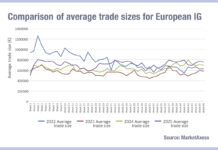The value proposition for execution management systems (EMSs) in fixed income markets has seen an about face in the past year. Buy-side firms who previously saw no value in an EMS for credit trading are now convinced that the outlay of hundreds of thousands of dollars a year can be matched by the returns an EMS can deliver.
Several factors have contributed to this change. The first is data. Access to data in credit markets has improved in quality and scope. Trading platforms are able to divulge more consistent information to a firm regarding its orders and trades, while trading data aggregators are able to provide greater levels of pre-trade and post-trade data about market-wide activity.
Trading counterparties engaged in market making are providing liquidity at smaller size and more frequently, supported by the model of trading indexed bonds that are components of exchange traded funds (ETFs), allowing them to create ETFs or redeem existing ETFs they hold to access their components, which lets them price those bonds with greater consistency than simple analysis of their activity would allow.
Collectively this makes one of the EMS’s core functions, the quantitative and ultimately more automated management of execution outcomes, a really effective process.
A second element is the increased interconnectivity between systems which is allowing EMSs to stage orders directly into electronic trading platforms so that they can be seamlessly traded from the desktop, without resorting to rekeying of the orders into the trading platforms’ inhouse interfaces.
By supporting this seamless workflow, feedback on orders becomes live and traders can work across the market via different platforms and counterparties more effectively.
Having a wider range of execution protocols gives traders better ways to achieve their objectives based on price. size and speed. It also allows a desk to scale up in both volume and range of instruments. The type of Ems being onboarded by a trading desk is often reflective of the funds for which it trades.
A passive house with more predictable trading patterns can often make greater use of a more standardised EMS, which gives it the benefit of lower costs and complexity in setting up and supporting the system, while reducing the level of customisability to exactly suit their execution preferences.
Active houses may prefer a customised trading system that can reflect their use of more varied trading approaches, timings and order sizes, allowing greater opportunity for alpha generation and active feedback into the investment process. cognisant of the trade off against a more costly and complex set-up.
The limits of EMSs in supporting multi-asset trading from the background of a single asset class speciality are well documented but traders report that these concerns are being overcome as data quality levels improve, and platform integration increases the capacity to electronify more complex trading approaches.
©Markets Media Europe 2025















